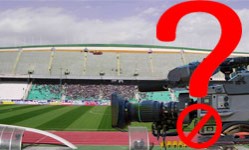
That may sound like a routine negotiation until one reads the terms of the agreement.
Bandar Abbas Municipality FC has agreed to pay, yes pay, the local broadcasting company (a government agency) 30 million Rials (US$3,000) to broadcast each game!
This may sound ridiculously funny, but it is wrong in so many ways.
Firstly, three thousand dollars may not sound much, but for the majority of lower league clubs in Iran, paying such a sum thirteen times a season will see their budgets disappear pretty quickly.
Secondly, the overwhelming majority of Iranian football clubs are directly or indirectly subsidized by the government or its subsidiaries.
So it seems odd that the National Broadcasting Agency, Bandar Abbas State and City governments, and Bandar Abbas Municipality FC (all government entities) should negotiate a method of payment. Their budgets are all allocated from the same pool.
But these two are minor issues compared to the third - clubs paying the broadcasting companies for airing their home matches.

Football is a product, a popular one at that. People tune in their televisions and radios to watch and hear the game broadcasts, creating opportunities for advertising. This is how the rest of the world’s football and broadcasting bodies collaborate.
This is how football clubs bring in most of their revenues. They sell their product (e.g. football matches) and get paid for it in return.
Furthermore, in most cases it is the national football federations and leagues that strike a deal and then distribute the revenue between the clubs so that smaller clubs are not left out to dry.
Other sources of revenue for football clubs are ticketing, sponsorship, merchandizing, and selling talented players to bigger clubs.
In Iran, most clubs do not get a share of the ticketing revenue, the municipality gets it all. Sponsorship is a joke because, as explained above, advertising revenue is nominal, and most of the industries that have the money to pay for sponsorship are government subsidiaries anyway.
Merchandising revenue is almost nonexistent because there are no laws protecting the brands meaning that anyone can use, or abuse, clubs brands without any fear of legal consequences.
That leaves selling young players as the only legitimate source of revenue. But then the laws protecting the clubs’ rights in these cases leave something to be desired. So often at the end of each season richer clubs descend upon smaller clubs and sign their best players.

The roots of Iran’s football problems run deep into its economic model. An estimated 60% of the economy in Iran is directly controlled and centrally planned by the state. That figure quickly grows even larger if the state subsidiaries are also included.
In such an economic model, ideas such as competition and advertising for products are almost meaningless. The government produces or imports most of the consumer products, and it is the government that sells the same products to consumers.
Therefore broadcasting companies that are funded by the government do not have large advertising revenues, and as a result they don’t have any incentive to purchase the right to broadcast soccer games.
Every year these government entities get an annual budget and whether they run a profitable operation or not the process is repeated the following year.
Of course there are ways to make the system work better. There are other countries with large public sectors in which the football establishment is doing just fine but in Iran there is no incentive to improve the system as long as the government dishes out the oil revenue every year.
It is hard to expect much improvement in Iran’s football infrastructure unless it is done in the context of larger economic reform.
Afshin Afshar